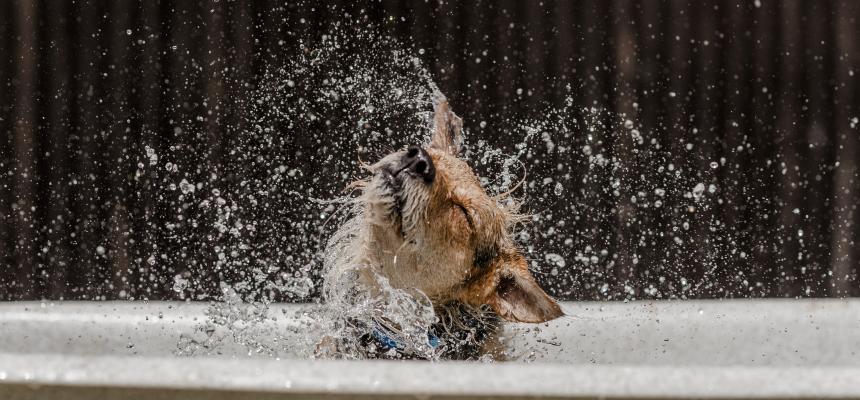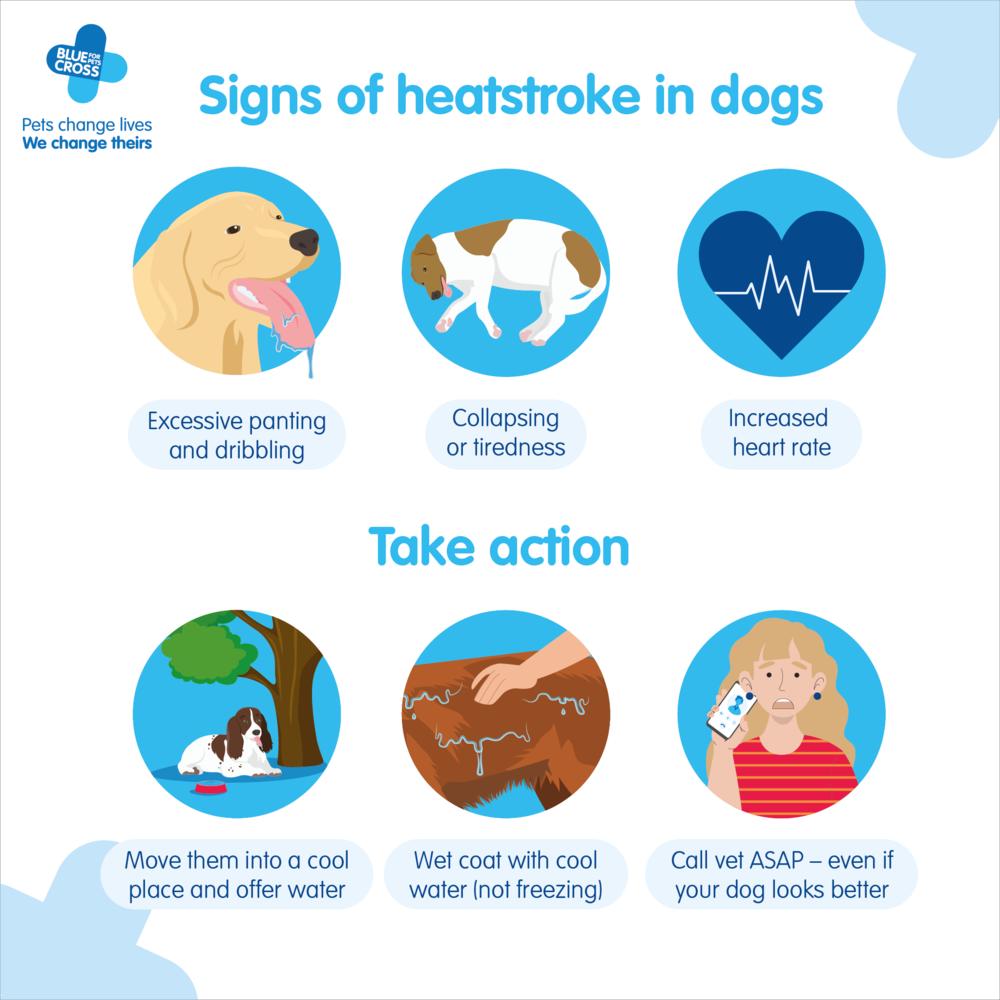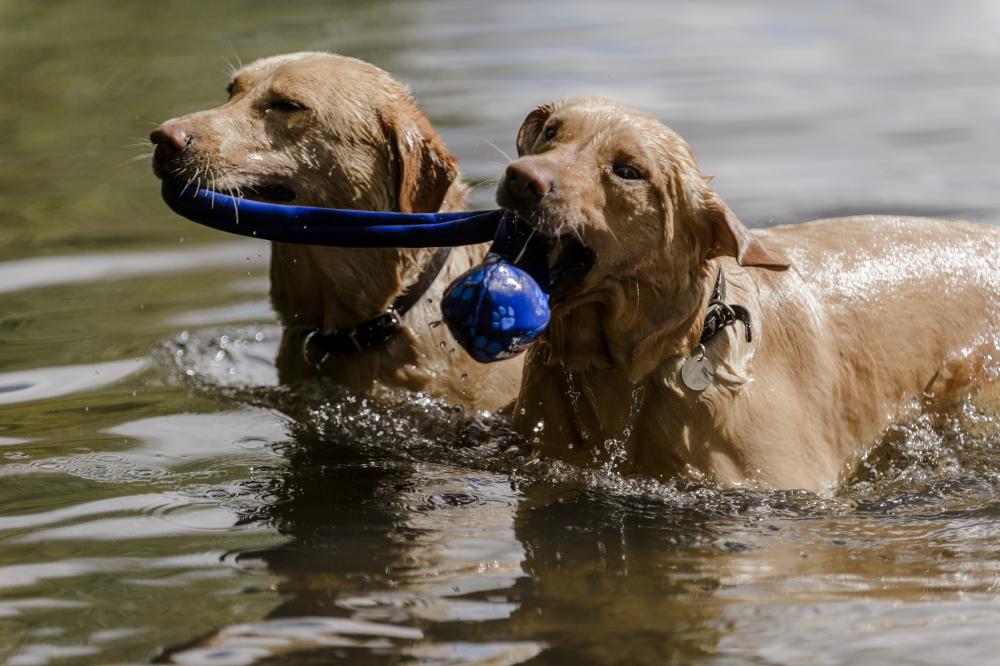More Great Information on your Dog and the Heat!


How to keep dogs cool in the summer heat
As temperatures rise, follow our guide to keeping your dog safe and having fun in the summer sun.
Heatstroke in dogs
Dogs can suffer fatal heatstroke within minutes. Unlike humans, dogs can’t sweat through their skin and so they rely on panting and releasing heat through their paw pads and nose to regulate their body temperature and keep cool. Imagine wearing a thick winter coat on a hot summer’s day and you’ll understand why dogs succumb to heatstroke so easily.
Signs of heatstroke in dogs include collapse, excessive panting, and dribbling.
If you suspect your pet is suffering from the condition, move them to a cool place, preferably with a draught, wet their coat with cool – not freezing – water, and contact your vet immediately.
Once a dog shows signs of heatstroke the damage is often already done, which is why it’s so important to prevent it.
Dogs in hot cars
Dogs succumb to heatstroke quickly. As above, they cannot sweat in the same way that people can and cannot keep cool as easily as we can. A car can become an oven very quickly even when it doesn’t feel that warm. When it is 22°C outside – within an hour – the temperature in a car can reach an unbearable 47°C.
Never leave a dog in a car, even for a moment. ‘Not long’ is too long.Off Important Off Blue
Can I smash a window to free a dog from a hot car?
If you see a dog in distress inside a car, official advice is to dial 999 immediately and ask for the police. A dog in distress in a hot car is an emergency and the police will advise you what to do based on the situation.
Depending on the severity of the situation, the police may attend and break into the car to gain access to the dog, or they may advise you to do this. If you decide to break into a car without proper justification, this could be classed as criminal damage and you may need to defend your actions in a court.
Call the police using 999 and tell them what you intend to do and why. Take pictures and/or videos of the dog in distress and the names and phone numbers of witnesses. The Criminal Damage Act 1971 provides a lawful excuse to commit damage if you believe that the owner of the property that you damage would consent to the damage if they knew the circumstances (under section 5(2)(a).
How to keep a dog cool and prevent heatstroke
- Make sure your dog has access to clean water at all times, ideally a large bowl filled to the brim. Carry water and a bowl with you on walks.
- On hot days, walk your dog during the cooler parts of the day, in the early morning and late evening
- Watch your pet for signs of over-heating, including heavy panting and loss of energy. If you recognise these signs when on a walk, stop, find a shady spot and give your dog water.
- Never leave your dog (or any pet) alone in a car, even with the windows open
- Make cooling tasty treats by making ice cubes with your dog’s favourite food inside or stuff a Kong and pop it in the freezer
- Be particularly careful with short nosed dogs such as bull breeds, boxers, pugs, older dogs, and those that are overweight. These dogs can get heatstroke simply by running around.

Exercising in the summer
As at all times of the year, by law your dog should be wearing a collar and tag with your name and address on it. It’s also a good idea to put both your home and mobile phone number on the tag so you can be contacted immediately if your dog wanders off.
Since April 2016 it has been a legal requirement for dogs to be microchipped. Most importantly, keep the details up to date so that you can always be reunited with your dog.
Walking
- Walk your dog at the cooler times of the day, either first thing in the morning or early evening
- Dogs’ paw pads can burn on hot pavements. As a general rule, if it’s too hot for your hand it’s too hot for their paws.
- If it’s too hot for the usual long walk, keep your dog mentally stimulated by doing some brain games instead. Refresh their basic training with some sits and stays, or teach them new tricks.
Swimming
- Swimming is excellent exercise for dogs and a great exercise alternative to walking in the summer heat. But remember that not all dogs like to swim, so if yours doesn’t then don’t force them and never throw a dog into water.
- Be wary of tides at the beach
- Drinking salt water is likely to make your dog sick and isn’t very good for them. Bring fresh water with you to the beach.
- Wash salt and sand off your dog’s coat after swimming to prevent it drying and irritating their skin
- Be careful to avoid heatstroke on the beach
- Watch out for currents in rivers
- Check freshwater lakes, rivers, ponds and canals to make sure they are clean before letting your dog dive in. Some types of algae, including blue-green algae, are toxic to dogs. If your dog swims in algae-contaminated water, contact your vet immediately.
- Dogs can and do drown in rivers and the sea. If your dog has inhaled water, contact your vet, as they can suffer complications.
- Sadly, each year dog owners drown trying to rescue their pets. Don’t risk dangerous situations.
Water intoxication: Top five things to look out for!
What is water intoxication?
Water intoxication is when dogs swallow too much water in a short space of time. It’s rare, but this condition can lead to brain damage and, in extreme circumstances, can be fatal.
Dogs can sometimes swallow too much water when they are swimming, so it’s key that you keep an eye on them when you’re treating them to a cool off.
Five signs that your dog may have water intoxication
- Vomiting
- Loss of coordination (this can include falling over or swaying)
- Bloating
- Tiredness
- Pale gums
If your dog starts to struggle with their breathing or loses consciousness after playing in the water, call your vet immediately.
How to stop your dog getting water intoxication
- Monitor your dog carefully while they’re playing in the water. If they look like they are swallowing a lot of water, take them out and allow them to relax.
- Limit the amount of time dogs spend playing in the water to 10 minutes, allowing them to go to the toilet in between swimming sessions and catch their breath
- Always carry fresh drinking water with you when at the beach. Swallowing a lot of salt water can lead to salt poisoning which has the same symptoms as water intoxication.

Summer skin and coat
Pale-coloured dogs are vulnerable to sunburn, particularly on their ears, noses and sparsely haired areas. Sun damage can lead to skin cancer which may require extensive surgery – even amputation in severe cases. Sunlight can also make existing skin conditions worse, particularly if your dog has allergies.
The best prevention is to keep your dog indoors when the sun is strongest, between 11.00am and 3.00pm. Alternatively, pop a T-shirt on your dog and cover vulnerable areas to protect them. You can also apply a non-toxic waterproof human sunblock or one specifically made for pets. If your dog’s skin looks sore, crusty or scaly, call your vet.
Take care of your dog’s delicate paws. If the pavement is too hot for your hand, it’s too hot for their paw pads too. Dog booties can be bought from pet shops and online, or walk your dog at cooler times of the day to prevent their paws burning.
Grooming your dog is important in the summer months, especially for longhaired breeds, to get rid of matts and tangles. A tangle-free coat will protect your pet’s delicate skin and help to keep them cool. Plus, if your pet’s coat is dirty and matted then you run the risk of flies laying their eggs and becoming maggots. Some breeds may need their coats trimming to keep them comfortable. Ask a professional groomer for advice.
If your dog swims or paddles in the sea to keep cool, remember to rinse the salt water and sand from your dog’s coat after to avoid drying out and irritating their skin.

Creepy crawlies and other dangers
Pests that love to bite your dog come out in their droves in summer. Fleas and ticks thrive in the heat and can be a real nuisance to your furry friend.
Fleas
Flea bites are annoying and itchy for most dogs, but if your dog is allergic to them then they can cause real discomfort and severe scratching, which can become infected.
Regular flea treatment is the only way to prevent these little critters – a one-off application won’t be enough. The most effective treatments come from your vet, so ask them for a recommendation.
If your dog has fleas you will need to treat your home as well to get rid of the eggs.
Ticks
Ticks are spider-like, egg-shaped creepy crawlies that are common in woodland, grassland and heath areas.
Ticks carry diseases, so it’s important to remove any that attach themselves to your dog. This can be tricky, as you need to be careful not to squeeze the tick’s body, or allow its head to get stuck inside your dog. Twisting them off your dog is the best removal method, and pet shops sell handy tick-removal devices to make this easier. Ask your vet for advice.
A few dogs catch Lyme disease annually in the UK, following a tick bite, and people can get the disease too.
Lyme disease is serious, so if you live in an area with a deer or sheep population you should consider tick treatment for your dog, which should kill the tick before they can transmit the disease.
Be particularly careful abroad as ticks in Europe can transmit a number of serious diseases.
If you are bitten by a tick, contact your doctor. Wearing trousers and long sleeves when walking through tick-infested areas will help prevent bites.
Bees and wasps
Dogs love to chase buzzing insects, but getting too close can be dangerous.
Most insect stings will simply cause your dog pain and irritation, but multiple stings can be fatal.
Dogs are also at risk when they snap at bees and wasps because this makes them more likely to be stung in the mouth or throat. Stings in these areas are hazardous because any swelling can block your pet’s airway.
Some dogs are allergic to bee and wasp stings, so watch out for signs of allergic reaction, including swelling and difficulty breathing.
If you think your dog has been stung multiple times, or is having an allergic reaction, take them to a vet straight away.
Adders
Adders are the only venomous snake in the UK, and while they tend to stay out of the way of humans and dogs, your pet may encounter one while exploring heathland, woodland or sandy areas.
Adders can be dangerous to dogs if disturbed because they bite when threatened.
If you think your dog has been bitten by an adder, call your vet straight away. Dogs are likely to survive adder bites if they are treated quickly. If you are able to, carry your dog rather than letting them walk to stop the venom spreading.
More from Blue Cross
Health Out and aboutWarning: Protect your dog from tick infectionsBehaviour Training and gamesHow to stop a dog from barkingEssentials Getting a dogDog laws UK

Was Jack and Jill adopted last weekend?
Hello,
Please check our website under the tab Available Dogs. Also, please know that our adoption process is very fluid, as we are coordinating between several people. If you are interested in one of our dogs, the best thing to do is to put in an application. One of our Adoption Team members will then contact you to discuss next steps.
Thank you.
ALR